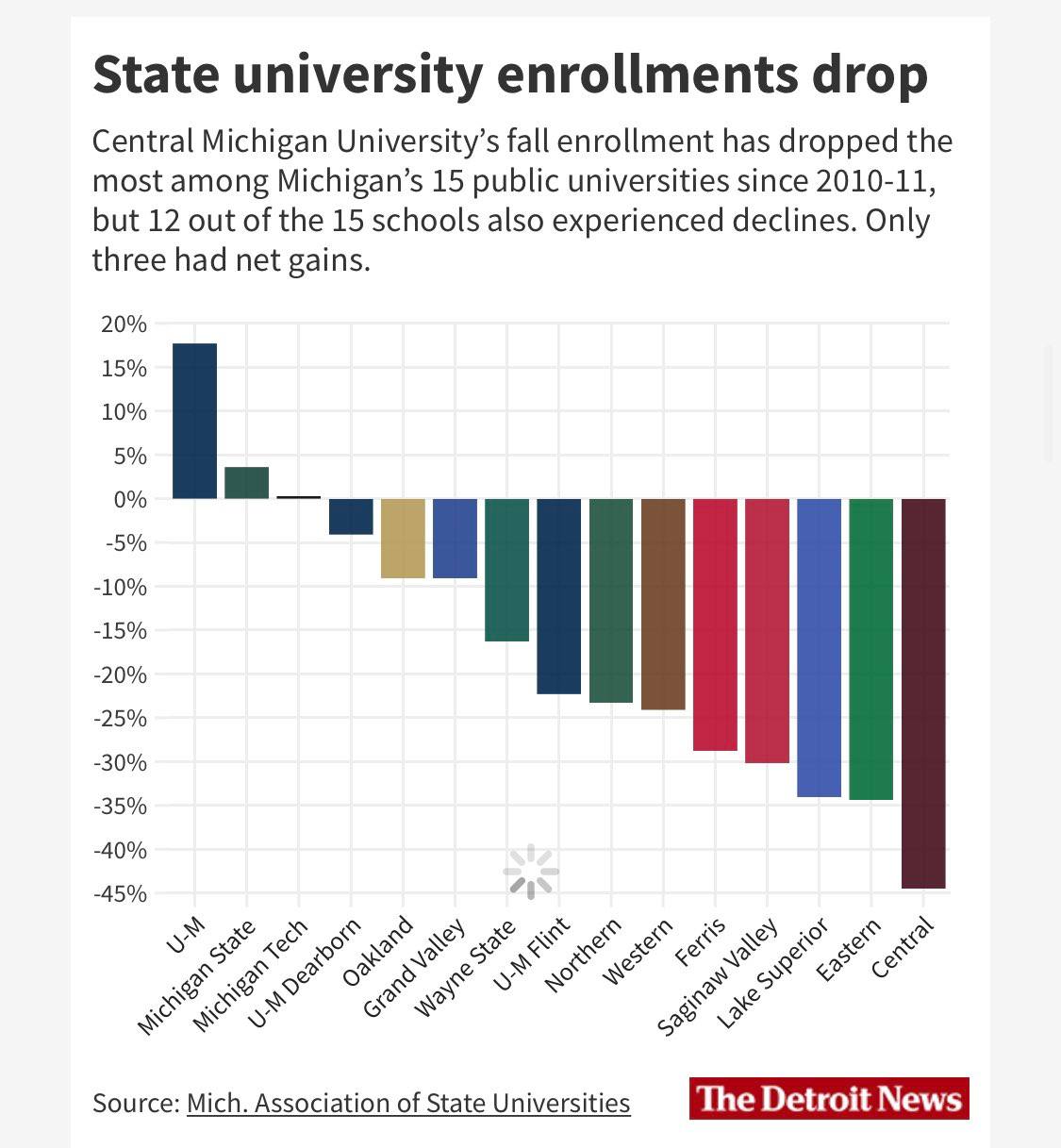
How is public higher education changing?
We have a new sketch of an answer to this question for one state. The Detroit News recently ran an article about Michigan’s public universities, focusing on enrollment. I’d like to share some of it here.
The overall picture is one of most Michigan public institutions losing enrollment over the past decade to various degrees, except for a couple enjoying the opposite experience:

Some of this is unsurprising. The University of Michigan is one of the world’s great universities. Michigan State is also highly ranked. Naturally they attract students (like myself, back in the day).
Yet, setting aside Michigan Tech’s near-plateau, I think the rest of the picture is not so well appreciated. Consider how many of those institutions saw their student numbers drop by values in the 20s – or 30s. Central Michigan University (CMU) lost nearly one half of its enrollment. It is actually closing up some residence halls this fall.
Now, those are all relative numbers, comparisons and proportions. What are the absolute numbers? According to Michigan Association of State Universities (MASU) data, total enrollment in state universities was 303,969 in 2011. By 2021 it fell to 262,985, roughly a 14% decline. 2022 numbers are still to come. 2011 seems to have been the peak, as I’ve noted elsewhere.
What’s behind this overall net loss?
The News article cites demographics, which makes sense, since Michigan’s overall population is barely growing: 9,883,640 in 2010 leading to 10,077,331 in 2020, according to Census data. The state’s median age is somewhere in the upper 30s, depending on source (Google versus Infoplease). Some are concerned that Michigan is aging up and out, producing fewer kids, as per the global demographic transition I’ve mentioned before.
The article also mentions COVID, although it adds that the decline predated the pandemic. And it adds a cultural detail:
“Lou Glazer, president of Michigan Future [states that] “you’ve got this drumbeat, which we think is inaccurate but is out there, that says getting a college degree is less valuable…”
Again, watch for that cultural shift. We may be moving away from uniformly thinking every needs more college.
CMU in particular might have been out-competed by its siblings – “University-provided documents also show school officials admit to being out-recruited by other universities, particularly in Metro Detroit” – yet the result seems to be a net decline for the system.
Jennifer DeHaemers, CMU vice president for student recruitment and retention [wrote]: “When enrollments reached a peak around 2010, a general sense of complacency overtook some areas of the university, creating a sense of satisfaction with outdated technology and leading to a failure to employ new and updated best practices of recruiting…”
What futures does this story suggest?
If the trend of the top two grow while the rest shrink continues, we might see cuts, consolidations, or closures for those experiencing the most difficulties.
The specter of this might spur some of the institutions to new recruiting strategies, from fierce competition with each other to building out new programs and expanding their reach, including online. Given Michigan’s splendid geography, I wonder how many students might head there to work on the climate crisis.
For now, this is a snapshot of one state’s public higher education enrollment.
(thanks to Tom Stroup for the story; to Ed Vielmetti and Brad Bernatek for sharing the MASU data, and MASU for aggregating it)
Related
